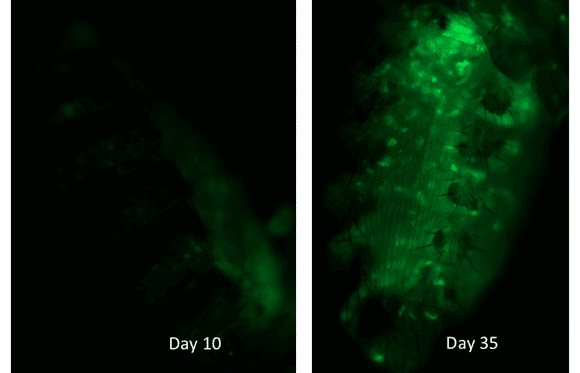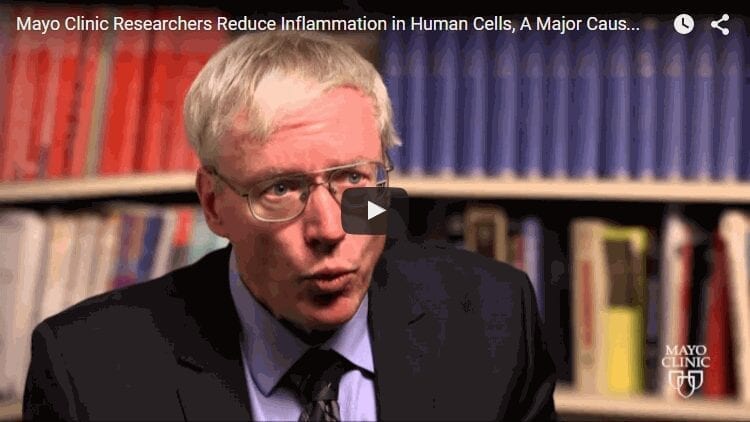
Fluorescence in the fat body of fruit flies tracks the activity of transposable elements of DNA. It increases markedly with age.
Jason Wood/Brown University
A new study in the Proceedings of the National Academy of Sciences provides substantial new evidence that health becomes endangered when aging cells lose control of rogue elements of DNA called transposons.
A new study increases and strengthens the links that have led scientists to propose the “transposon theory of aging.” Transposons are rogue elements of DNA that break free in aging cells and rewrite themselves elsewhere in the genome, potentially creating lifespan-shortening chaos in the genetic makeups of tissues.
As cells get older, prior studies have shown, tightly wound heterochromatin wrapping that typically imprisons transposons becomes looser, allowing them to slip out of their positions in chromosomes and move to new ones, disrupting normal cell function. Meanwhile, scientists have shown that potentially related interventions, such as restricting calories or manipulating certain genes, can demonstrably lengthen lifespans in laboratory animals.
“In this report the big step forward is towards the possibility of a true causal relationship,” said Dr. Stephen Helfand, Brown University professor of biology and senior author of a new study in the Proceedings of the National Academy of Sciences. “So far there have been associations and suggestions that to all of us make sense, but the difference in science is that you need the data to back up your opinion.”
Many lines of evidence
The new results, led by faculty investigator Jason Wood, come from several experiments that are thorough and direct in connecting the dots among weakening heterochromatin, increased transposon expression, aging and lifespan.
In one set of experiments, the team visually caught transposable elements in the act of jumping around in fruit flies as they aged. They inserted special genetic snippets into fat body cells, the equivalent of human liver and fat cells in flies that would glow bright green when specific transposable elements move about in the genome. Under the microscope the scientists could see a clear pattern of how the glowing “traps” lit up more and more as the flies aged.
The increase in transposon activity was not steady as flies grew older. “Flies reach a certain age and then it takes off more exponentially,” Wood said. The data show that the timeframe in which transposable element activity really begins to increase is tightly correlated with the time when the flies start to die.
Several experiments in the paper also show that that a key intervention already known to increase lifespan, a low-calorie diet, dramatically delays the onset of increased transposon activity.
To further explore the connection between transposon expression and lifespan, the team tested the effects of manipulating genes known to improve heterochromatin repression that are not only found in flies, but also in mammals. For example, increasing expression of the gene Su(var)3-9, which helps form heterochromatin, extended maximal fly lifespan from 60 to 80 days. Increasing expression of a gene called Dicer-2, which uses the small RNA pathway to suppress transposons, added significantly to lifespan as well.
Finally, they showed that an anti-HIV drug called 3TC, which inhibits activation of transposons and their movement into new positions in the genome, can restore some lifespan to flies that have a mutation that disables Dicer-2.
More to do
For all the new results, Helfand said it’s still not quite time to declare outright that transposons are a cause of aging’s health effects.
“They make a strong story,” he said. “We’re starting to put the flesh on the skeleton.”
But new experiments are planned. For example, the team will purposely encourage expression of transposable elements to see if that undermines health and lifespan. Another approach could be to use the powerful CRISPR gene editing technique to specifically disable the ability of transposable elements to mobilize within the genome. If that intervention affected lifespan, it would be telling as well, Helfand said.
The team is also continuing to develop drug interventions in hopes of increasing its efficacy and learning more about its safety.
Brown is also leading a new $9.7 million grant with New York University and the University of Rochester to further advance the study of transposons in aging.
While transposons appear to be a significant factor in aging, Helfand and Wood said, they are likely to be only part of a broader set of processes that undermine health over time.
“There are lots of potential mechanisms that influence the aging process,” Wood said. “There are a lot of things going on, but we think this is one of them.”
Learn more: Study results advance ‘transposon theory of aging’
The Latest on: Transposon theory of aging
[google_news title=”” keyword=”transposon theory of aging” num_posts=”10″ blurb_length=”0″ show_thumb=”left”]
via Google News
The Latest on: Transposon theory of aging
- Aging In Place Statistics And Facts In 2024on May 2, 2024 at 2:55 am
Aging in place successfully requires careful planning, and oftentimes, a caregiver, social support system and consideration of potential future health issues, such as heart disease, diabetes and ...
- Healthy Aging Newson April 14, 2024 at 5:00 pm
Researchers Find That Accelerated Aging Biology in the Placenta Contributes to a Rare Form of Pregnancy-Related Heart Failure Apr. 17, 2024 — In a new study, researchers show that elevated ...
- Sign of Aging Reversed by Simple Exerciseon April 12, 2024 at 2:00 am
Scientists have identified a new sign of biological aging that may be reversible through simple exercise. Most of us see aging as an inevitable process of life, but some scientists are beginning ...
- Fear of aging is really a fear of the unknown and modern society is making things worse, say researcherson February 1, 2024 at 8:25 am
His information theory of aging argues that reprogramming DNA can improve damaged and old tissues, and delay or even reverse aging. However, these new possibilities can also heighten our fear of ...
- Neutral Theory: The Null Hypothesis of Molecular Evolutionon March 21, 2023 at 6:29 am
In the decades since its introduction, the neutral theory of evolution has become central to the study of evolution at the molecular level, in part because it provides a way to make strong ...
- Enigma of Agingon May 18, 2022 at 10:14 pm
While there are many definitions and theories of aging, readers can think of their own bodies as becoming increasingly vulnerable to all sorts of stressors from those things we inherit and from those ...
- Researchers Draw New Connections Between Aging and Mitochondrial Healthon August 25, 2021 at 1:14 pm
The best-known theory of biological aging emerged in the 1950s. Denham Harman, a biochemist at the University of California, Berkeley, proposed that as cells metabolize nutrients and consume ...
- Theories of Autismon July 10, 2020 at 1:42 am
Over time, researchers have proposed various theories of the condition from the diametric mind to the extreme male brain to the social motivation hypothesis and many others. All hope to weave the ...
- DNA and agingon April 13, 2019 at 12:37 pm
One of the major theories of aging, proposed by Harman in 1956, suggests that it is caused by the accumulation of oxidative damage affecting macromolecules, DNA, RNA and proteins, and possibly ...
via Bing News











